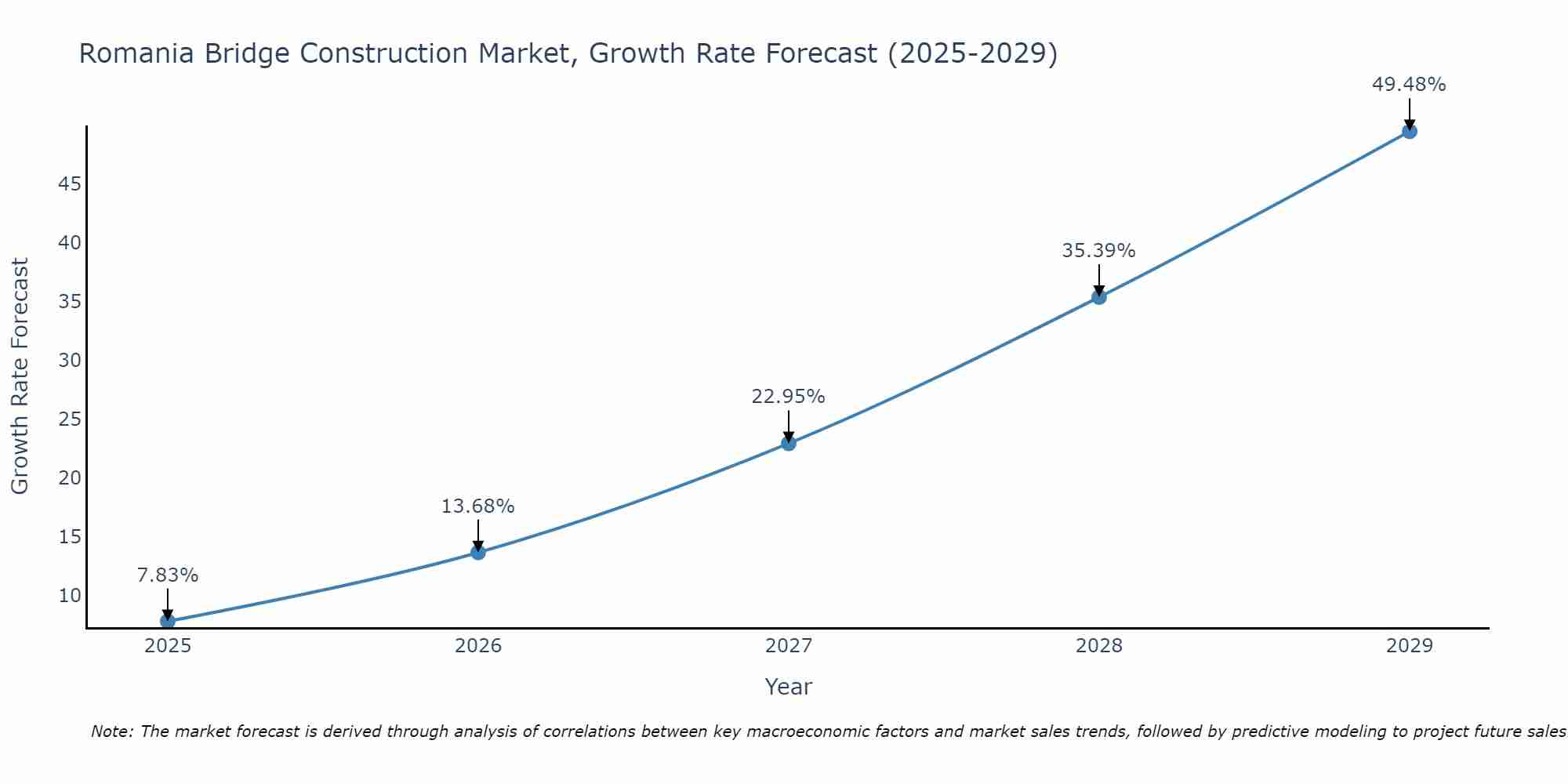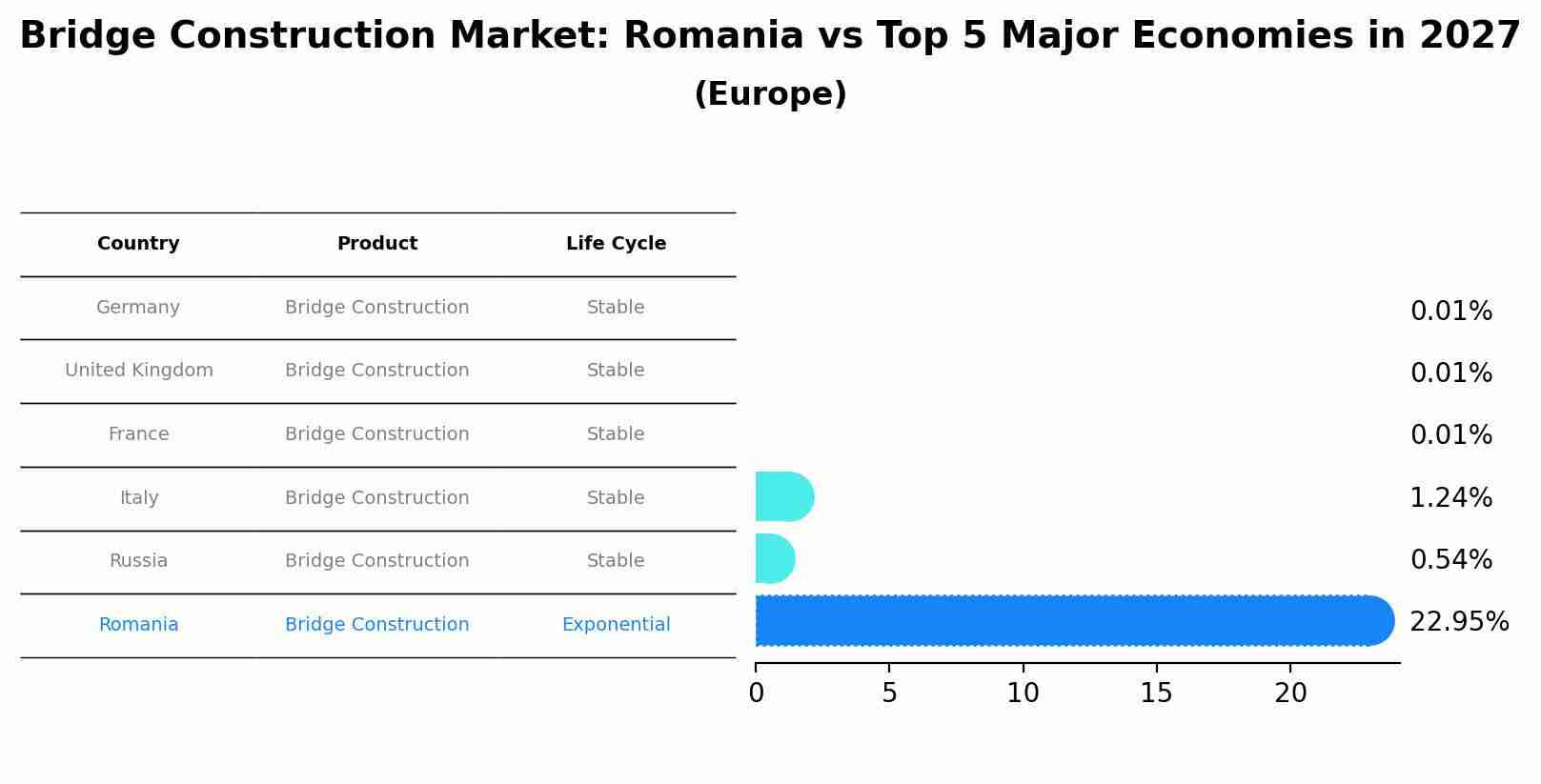Romania Bridge Construction Market Outlook | Industry, Companies, Share, Growth, Size, Trends, Revenue, Analysis, Forecast, Value & COVID-19 IMPACT
| Product Code: ETC360078 | Publication Date: Aug 2022 | Updated Date: Aug 2025 | Product Type: Market Research Report | |
| Publisher: 6Wresearch | Author: Dhaval Chaurasia | No. of Pages: 75 | No. of Figures: 35 | No. of Tables: 20 |
Romania Bridge Construction Market Size Growth Rate
The Romania Bridge Construction Market is poised for steady growth rate improvements from 2025 to 2029. Commencing at 7.83% in 2025, growth builds up to 49.48% by 2029.

Bridge Construction Market: Romania vs Top 5 Major Economies in 2027 (Europe)
In the Europe region, the Bridge Construction market in Romania is projected to expand at a exponential growth rate of 22.95% by 2027. The largest economy is Germany, followed by United Kingdom, France, Italy and Russia.

Romania Bridge Construction Market Synopsis
The Romania Bridge Construction Market is experiencing steady growth due to increasing infrastructure development projects across the country. Major factors driving the market include government investments in transportation infrastructure, the need to replace aging bridges, and the growing demand for modern, efficient transportation networks. Key players in the market are focusing on innovative bridge design and construction methods to improve project efficiency and sustainability. Additionally, the market is witnessing a rise in public-private partnerships for bridge construction projects. Challenges such as regulatory hurdles, environmental concerns, and skilled labor shortages are being addressed through collaboration between industry stakeholders and government bodies. Overall, the Romania Bridge Construction Market presents opportunities for growth and innovation in the coming years.
Romania Bridge Construction Market Trends
The Romania Bridge Construction Market is currently experiencing significant growth driven by a surge in infrastructure development projects across the country. Key trends in the market include a focus on sustainability and eco-friendly construction practices, the adoption of advanced technologies such as Building Information Modeling (BIM) for efficient project management, and an increasing emphasis on enhancing the durability and longevity of bridge structures. Furthermore, public-private partnerships are playing a crucial role in funding major bridge construction projects, while the government`s investments in upgrading and expanding transportation networks are driving the demand for new bridge construction. Overall, the market is witnessing a shift towards innovative design solutions and construction techniques to meet the evolving needs of the infrastructure sector in Romania.
Romania Bridge Construction Market Challenges
In the Romania Bridge Construction Market, some major challenges include regulatory hurdles and bureaucratic processes, which can delay project timelines and increase costs. Additionally, funding constraints and budget limitations may hinder the development of new bridge construction projects. The availability of skilled labor and specialized expertise in bridge construction can also be a challenge, leading to potential delays and quality issues in the execution of projects. Moreover, navigating complex procurement processes and dealing with competitive pricing pressures from both domestic and international players further add to the challenges faced by companies operating in the Romania Bridge Construction Market. Overall, addressing these challenges requires efficient project management practices, strategic partnerships, and a deep understanding of the local market dynamics.
Romania Bridge Construction Market Investment Opportunities
The Romania Bridge Construction Market presents several investment opportunities due to the country`s focus on infrastructure development and modernization. With various ongoing and planned bridge construction projects aimed at improving transportation networks and connectivity within the region, investors can consider opportunities in bridge design and engineering services, construction materials supply, project management, and technology solutions for efficient bridge construction. Additionally, public-private partnership (PPP) models are increasingly being utilized for infrastructure projects in Romania, offering potential investment avenues for private investors and contractors. Investing in the Romania Bridge Construction Market can provide long-term growth potential and returns as the country continues to invest in its infrastructure to support economic growth and enhance connectivity.
Jordan Agar Market Government Policies
The Romanian government has been actively promoting infrastructure development, including bridge construction, through various policies and initiatives. The government has allocated significant funding for infrastructure projects, including bridges, as part of its National Transport Master Plan. Additionally, public-private partnerships (PPPs) are encouraged to accelerate the development of infrastructure projects, offering attractive incentives and streamlined approval processes. The government is also focused on ensuring that bridge construction projects adhere to high quality and safety standards by enforcing strict regulations and conducting thorough inspections. Overall, the government`s policies aim to stimulate growth in the bridge construction market, attract investment, and improve connectivity and transportation efficiency across Romania.
Romania Bridge Construction Market Future Outlook
The future outlook for the Romania Bridge Construction Market appears promising, driven by several key factors. The government`s focus on infrastructure development, including plans to improve and expand the transportation network, will create a demand for new bridge construction projects. Additionally, the increasing urbanization and population growth in Romania will necessitate the construction of more bridges to connect growing cities and regions. Technological advancements in bridge design and construction methods will also play a significant role in shaping the market, leading to more efficient and sustainable bridge projects. Overall, the Romania Bridge Construction Market is expected to experience steady growth in the coming years, presenting opportunities for both local and international construction companies to participate in this evolving sector.
Key Highlights of the Report:
- Romania Bridge Construction Market Outlook
- Market Size of Romania Bridge Construction Market, 2021
- Forecast of Romania Bridge Construction Market, 2031
- Historical Data and Forecast of Romania Bridge Construction Revenues & Volume for the Period 2018 - 2031
- Romania Bridge Construction Market Trend Evolution
- Romania Bridge Construction Market Drivers and Challenges
- Romania Bridge Construction Price Trends
- Romania Bridge Construction Porter's Five Forces
- Romania Bridge Construction Industry Life Cycle
- Historical Data and Forecast of Romania Bridge Construction Market Revenues & Volume By Type for the Period 2018 - 2031
- Historical Data and Forecast of Romania Bridge Construction Market Revenues & Volume By Beam Bridge for the Period 2018 - 2031
- Historical Data and Forecast of Romania Bridge Construction Market Revenues & Volume By Truss Bridge for the Period 2018 - 2031
- Historical Data and Forecast of Romania Bridge Construction Market Revenues & Volume By Arch Bridge for the Period 2018 - 2031
- Historical Data and Forecast of Romania Bridge Construction Market Revenues & Volume By Suspension Bridge for the Period 2018 - 2031
- Historical Data and Forecast of Romania Bridge Construction Market Revenues & Volume By Cable-Stayed Bridge for the Period 2018 - 2031
- Historical Data and Forecast of Romania Bridge Construction Market Revenues & Volume By Others for the Period 2018 - 2031
- Historical Data and Forecast of Romania Bridge Construction Market Revenues & Volume By Material for the Period 2018 - 2031
- Historical Data and Forecast of Romania Bridge Construction Market Revenues & Volume By Steel for the Period 2018 - 2031
- Historical Data and Forecast of Romania Bridge Construction Market Revenues & Volume By Concrete for the Period 2018 - 2031
- Historical Data and Forecast of Romania Bridge Construction Market Revenues & Volume By Composite Material for the Period 2018 - 2031
- Historical Data and Forecast of Romania Bridge Construction Market Revenues & Volume By Application for the Period 2018 - 2031
- Historical Data and Forecast of Romania Bridge Construction Market Revenues & Volume By Road & Highway for the Period 2018 - 2031
- Historical Data and Forecast of Romania Bridge Construction Market Revenues & Volume By Railway for the Period 2018 - 2031
- Romania Bridge Construction Import Export Trade Statistics
- Market Opportunity Assessment By Type
- Market Opportunity Assessment By Material
- Market Opportunity Assessment By Application
- Romania Bridge Construction Top Companies Market Share
- Romania Bridge Construction Competitive Benchmarking By Technical and Operational Parameters
- Romania Bridge Construction Company Profiles
- Romania Bridge Construction Key Strategic Recommendations
Frequently Asked Questions About the Market Study (FAQs):
- Single User License$ 1,995
- Department License$ 2,400
- Site License$ 3,120
- Global License$ 3,795
Search
Related Reports
- Vietnam System Integrator Market (2025-2031) | Size, Companies, Analysis, Industry, Value, Forecast, Growth, Trends, Revenue & Share
- ASEAN and Thailand Brain Health Supplements Market (2025-2031) | Strategy, Consumer Insights, Analysis, Investment Trends, Opportunities, Growth, Size, Share, Industry, Revenue, Segments, Value, Segmentation, Supply, Forecast, Restraints, Outlook, Competition, Drivers, Trends, Demand, Pricing Analysis, Competitive, Strategic Insights, Companies, Challenges
- ASEAN Bearings Market (2025-2031) | Strategy, Consumer Insights, Analysis, Investment Trends, Opportunities, Growth, Size, Share, Industry, Revenue, Segments, Value, Segmentation, Supply, Forecast, Restraints, Outlook, Competition, Drivers, Trends, Demand, Pricing Analysis, Competitive, Strategic Insights, Companies, Challenges
- Europe Flooring Market (2025-2031) | Outlook, Share, Industry, Trends, Forecast, Companies, Revenue, Size, Analysis, Growth & Value
- Saudi Arabia Manlift Market (2025-2031) | Outlook, Size, Growth, Trends, Companies, Industry, Revenue, Value, Share, Forecast & Analysis
- Uganda Excavator, Crane, and Wheel Loaders Market (2025-2031) | Strategy, Consumer Insights, Analysis, Investment Trends, Opportunities, Growth, Size, Share, Industry, Revenue, Segments, Value, Segmentation, Supply, Forecast, Restraints, Outlook, Competition, Drivers, Trends, Demand, Pricing Analysis, Competitive, Strategic Insights, Companies, Challenges
- Rwanda Excavator, Crane, and Wheel Loaders Market (2025-2031) | Strategy, Consumer Insights, Analysis, Investment Trends, Opportunities, Growth, Size, Share, Industry, Revenue, Segments, Value, Segmentation, Supply, Forecast, Restraints, Outlook, Competition, Drivers, Trends, Demand, Pricing Analysis, Competitive, Strategic Insights, Companies, Challenges
- Kenya Excavator, Crane, and Wheel Loaders Market (2025-2031) | Strategy, Consumer Insights, Analysis, Investment Trends, Opportunities, Growth, Size, Share, Industry, Revenue, Segments, Value, Segmentation, Supply, Forecast, Restraints, Outlook, Competition, Drivers, Trends, Demand, Pricing Analysis, Competitive, Strategic Insights, Companies, Challenges
- Angola Excavator, Crane, and Wheel Loaders Market (2025-2031) | Strategy, Consumer Insights, Analysis, Investment Trends, Opportunities, Growth, Size, Share, Industry, Revenue, Segments, Value, Segmentation, Supply, Forecast, Restraints, Outlook, Competition, Drivers, Trends, Demand, Pricing Analysis, Competitive, Strategic Insights, Companies, Challenges
- Israel Intelligent Transport System Market (2025-2031) | Strategy, Consumer Insights, Analysis, Investment Trends, Opportunities, Growth, Size, Share, Industry, Revenue, Segments, Value, Segmentation, Supply, Forecast, Restraints, Outlook, Competition, Drivers, Trends, Demand, Pricing Analysis, Competitive, Strategic Insights, Companies, Challenges
Industry Events and Analyst Meet
Our Clients
Whitepaper
- Middle East & Africa Commercial Security Market Click here to view more.
- Middle East & Africa Fire Safety Systems & Equipment Market Click here to view more.
- GCC Drone Market Click here to view more.
- Middle East Lighting Fixture Market Click here to view more.
- GCC Physical & Perimeter Security Market Click here to view more.
6WResearch In News
- Doha a strategic location for EV manufacturing hub: IPA Qatar
- Demand for luxury TVs surging in the GCC, says Samsung
- Empowering Growth: The Thriving Journey of Bangladesh’s Cable Industry
- Demand for luxury TVs surging in the GCC, says Samsung
- Video call with a traditional healer? Once unthinkable, it’s now common in South Africa
- Intelligent Buildings To Smooth GCC’s Path To Net Zero













